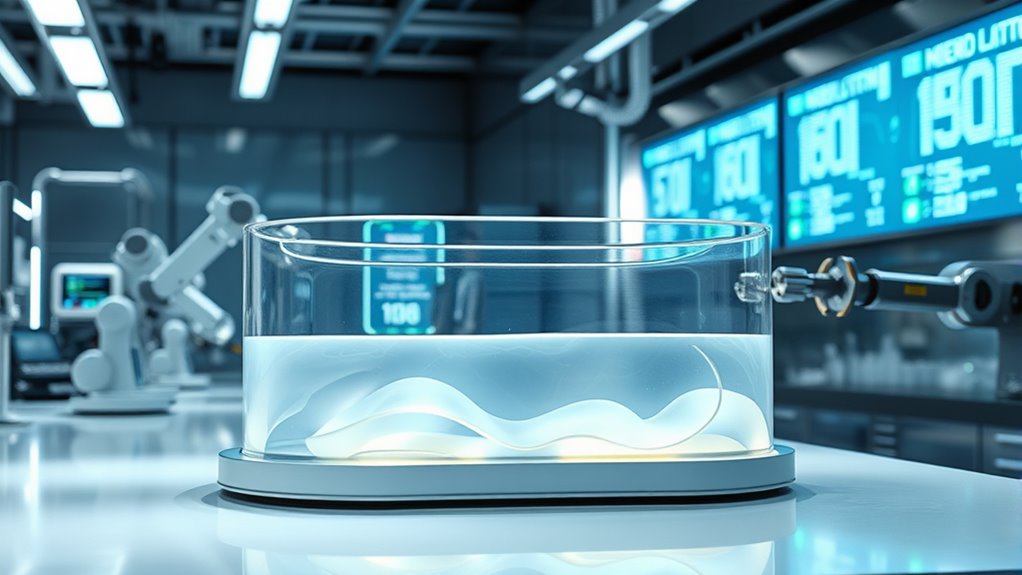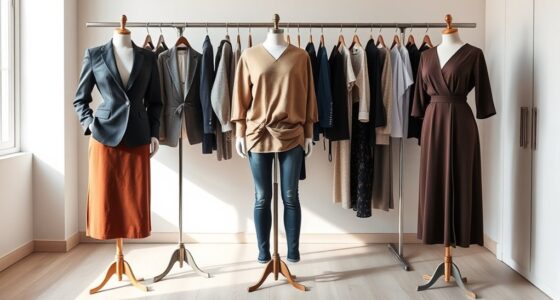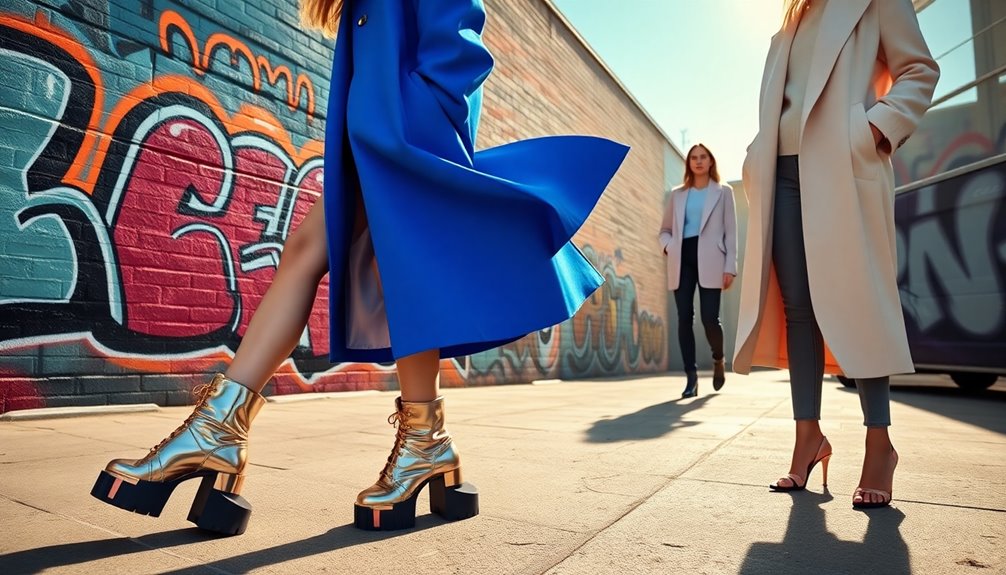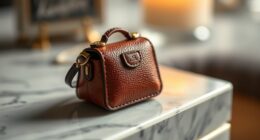Bio-fabricated leather is transforming the fashion industry by replacing livestock with lab-grown materials. Made through cell culture technology, it mimics traditional leather’s look, feel, and durability but uses markedly less water, energy, and harmful chemicals. This cruelty-free alternative reduces environmental impact and supports ethical practices. As brands adopt this innovative material, you can expect more sustainable, stylish options soon. Discover how this shift is shaping the future of eco-conscious fashion.
Key Takeaways
- Bio-fabricated leather is produced in labs using cell cultures, eliminating the need for livestock farming.
- It offers a cruelty-free, sustainable alternative that reduces water, energy, and chemical use in leather production.
- The material closely mimics traditional leather in texture, durability, and appearance for various fashion products.
- Growing consumer demand and industry innovation are accelerating the shift toward lab-grown, eco-friendly leather.
- Widespread adoption promotes ethical sourcing, environmental preservation, and a more sustainable fashion industry.

Bio-fabricated leather is revolutionizing the way we think about sustainable fashion and materials. It’s a game-changer for anyone looking to reduce their environmental footprint while still enjoying stylish, high-quality products. Unlike traditional leather, which involves raising livestock, bio-fabricated leather is created in labs using cell cultures. This means you can enjoy the look and feel of genuine leather without the environmental costs associated with farming and slaughtering animals. As someone interested in sustainable fashion, this innovation aligns perfectly with your desire to support ethical sourcing practices. You no longer have to compromise your values for style; bio-fabricated leather offers a cruelty-free alternative that’s better for the planet.
When you choose products made from bio-fabricated leather, you’re actively supporting a shift toward more ethical sourcing. Traditional leather production is resource-intensive, requiring large amounts of water, land, and energy, and it often involves harmful chemicals in tanning processes. In contrast, lab-grown leather is produced with considerably less water and energy, and it eliminates the need for harmful chemicals. This makes it a more responsible choice, reducing environmental degradation and helping to preserve ecosystems. By opting for bio-fabricated leather, you’re contributing to a more sustainable fashion industry that prioritizes environmental health and animal welfare. Ethical sourcing extends beyond just the environmental benefits; it also means supporting innovations that avoid exploitation and cruelty. You can feel confident that your fashion choices are aligned with your values, knowing that the materials you wear are grown in controlled environments without causing harm.
Moreover, bio-fabricated leather doesn’t sacrifice quality or aesthetics. It can be engineered to mimic the texture, durability, and flexibility of traditional leather, making it suitable for everything from handbags to footwear. This means you can enjoy trendy, high-end designs that are both stylish and eco-conscious. As awareness around sustainability grows, more brands are adopting bio-fabricated leather, making it easier for you to find ethically sourced and environmentally friendly options. By choosing these products, you’re not just making a personal style statement—you’re also encouraging the industry to innovate in ways that prioritize sustainability and animal welfare. This shift in consumer demand pushes companies to rethink their supply chains and adopt more ethical sourcing practices.
In essence, bio-fabricated leather empowers you to make fashion choices that are both fashionable and responsible. It’s an exciting development that challenges the status quo of traditional leather production, offering a more sustainable, cruelty-free alternative. As you explore new brands and designs, remember that your support can drive change. Every purchase of bio-fabricated leather is a step toward a more ethical and environmentally friendly fashion future—one where labs replace livestock and sustainability becomes the norm. Additionally, understanding the sustainable materials can deepen your appreciation for innovations like lab-grown leather and their impact on the environment. By choosing bio-fabricated leather, you are supporting sustainable innovation that could redefine the future of fashion.
Frequently Asked Questions
How Does Bio-Fabricated Leather Compare in Durability to Traditional Leather?
When comparing durability, synthetic materials like bio-fabricated leather often excel in certain areas. You’ll find that it offers impressive synthetic durability, resisting scratches and wear better than traditional leather. Plus, its material flexibility allows it to bend and stretch without cracking, making it suitable for various uses. While conventional leather may age beautifully, lab-grown alternatives provide a consistent, eco-friendly option that maintains durability over time.
What Are the Environmental Impacts of Producing Lab-Grown Leather?
You might think lab-grown leather has significant environmental impacts, but evidence suggests it’s more sustainable. By adopting sustainable practices, it reduces resource consumption like water and land compared to traditional methods. additionally, it minimizes greenhouse gas emissions and waste. While not entirely impact-free, producing lab-grown leather conserves resources and supports eco-friendly innovations, making it a promising alternative for reducing our ecological footprint while maintaining quality and durability.
Is Bio-Fabricated Leather Cost-Effective for Mass Production?
You might wonder if bio-fabricated leather is cost-effective for mass production. When you look at the cost analysis, it’s promising but still faces scalability challenges. Producing lab-grown leather requires advanced technology and significant investment, which can drive up costs initially. However, as production scales up and innovations improve, costs could decrease, making it more competitive with traditional leather in the future.
Can Bio-Fabricated Leather Be Customized for Different Textures and Colors?
Ever wondered if bio-fabricated leather can match your unique style? The answer is yes. Advanced technology now allows for incredible texture customization and diverse color options, so you can create exactly what you envision. Labs can tweak the material’s structure and pigments, giving you endless possibilities. This means your designs won’t be limited—your creativity can truly shine, making bio-fabricated leather a versatile choice for any fashion statement.
What Are the Current Regulatory Standards for Bio-Fabricated Leather?
You should know that regulatory oversight and safety standards for bio-fabricated leather are still evolving. Currently, agencies are working to develop guidelines to guarantee products are safe, sustainable, and ethically produced. As a consumer or producer, you’ll want to stay informed about these standards, which may include testing for contaminants, allergen safety, and environmental impact. Compliance ensures your bio-fabricated leather meets the necessary regulations before reaching the market.
Conclusion
As you consider bio-fabricated leather, it’s almost poetic how science and nature converge—labs now mimic what once only came from livestock. You realize that, in a strange twist of fate, the innovations born from human ingenuity might just shape a more sustainable future, quietly replacing old habits. Sometimes, it feels like the very advancement that challenges tradition was waiting in the wings all along, ready to redefine what’s possible when technology and nature unexpectedly align.









